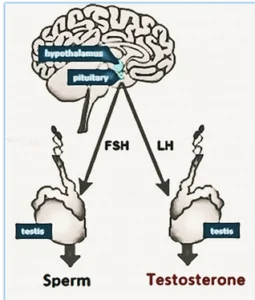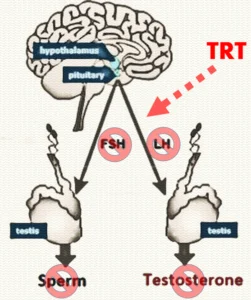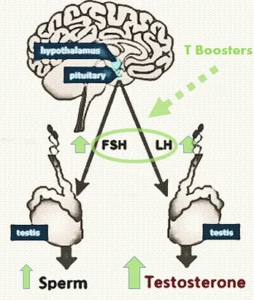Hormonal imbalance, particularly testosterone deficiency, is directly related to your sex drive/intimacy as well as your erection function. However, the negative side effects of low testosterone go much further, and may hurt your heart health, bone health, and even your cognitive (brain) health, focus, memory and concentration.
At 360 Urology, our treatment algorithm is safe, effective, and most importantly, guideline based. Do your research. And then allow us to help you be your best you!

The process of testosterone release starts with the hormones from the brain. FSH & LH are hormones released by the brain. FSH triggers sperm production (spermatogenesis) from the testicle while LH triggers testosterone production from the testicle.
Testosterone replacement therapy (TRT) will give you a rapid rise in total body testosterone. This may improve your energy, sex drive, and work synergistically with your treatment for erectile dysfunction to improve your erections immediately.

TRT may also have a long term positive impact on your heart and bone health.
However, TRT will trigger your brain to think you have enough testosterone and shut down FSH & LH production from the brain. This can have a long term negative impact on your sperm production/fertility and natural testosterone production from the testicle. For this reason, testosterone replacement is not recommended for men who wish to preserve their fertility.
Long term use of testosterone can result in dependence as the testicle may lose its ability to function independently over time.

For men concerned about the long term repercussion of TRT, particularly younger men, we will discuss T boosters that can either be taken with testosterone therapy, or independently, to either stimulate the testicle while taking testosterone, or boost the testicles so that they work harder and more effectively without the need for testosterone replacement.
If you are interested in optimizing your hormones, but are concerned about the side effects of TRT, talk to your 360 provider today and get your hormone therapy done right.
These are the most cost effective and most commonly used treatment type. These are either subcutaneous (injected into the fat) or intramuscular (injected into the muscle) and are typically self-injected weekly or biweekly.
This is the simplest treatment option. It does require daily application of a gel or foam and does have the risk of transference (transfer of testosterone to another member of the household if touched before it dries).
This is the most convenient option. Rice grain sized pellets are painlessly placed under the skin to allow for prolonged steady release of testosterone. Pellets are most commonly inserted every 3-4 months.
This is the least recommended option because of potential negative effects on the liver. however, oral and intranasal options do have the least negative impact on fertility and may be an option for younger men.